Invisalign – Dallas, TX
The Smile You’ve Always Wanted, Without Metal Braces
Have you always wanted to correct your crooked, crowded, or gapped teeth, without wearing brackets and wires? With Invisalign, you can! This outstanding alternative to metal braces gives you the healthy, beautiful smile you’ve always wanted, comfortably and discreetly. And with the expert care of our Invisalign-certified dentists, Dr. Spillman and Dr. Green, you can count on top-notch treatment from start to finish. Learn more about Invisalign below, and contact us anytime with additional questions or to schedule a consultation!
Why Choose The Dental Center of Lakewood for Invisalign?
- Experienced Team of Dentists With Advanced Orthodontic Training
- We Love Working With Patients of All Ages
- Custom Treatment Plans That Meet Your Specific Needs
How Does Invisalign Work?
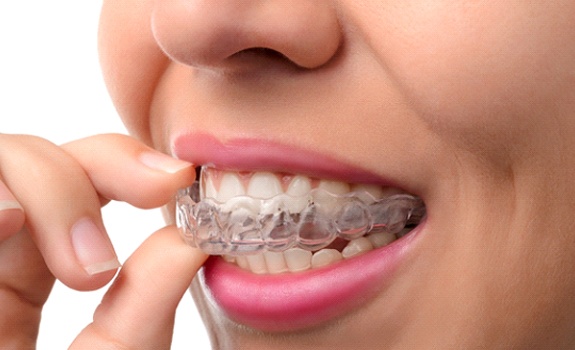
Any type of orthodontic treatment works by applying pressure to the teeth to move them into proper alignment over time. But, whereas traditional braces rely on brackets and wires, Invisalign uses clear aligner trays that fit snugly over the teeth.
In addition to straightening your teeth invisibly, removable trays also give you the benefit of taking them out before eating or brushing your teeth. And while you’ll need to wear the aligners at least 20 to 22 hours per day to get your results on time, you still have the flexibility to remove them for special events like weddings or job interviews. Another advantage is that Invisalign is often completed faster (the average treatment time is 12 to 18 months as opposed to 18 to 24 months for metal braces).
What Is the Process Like?
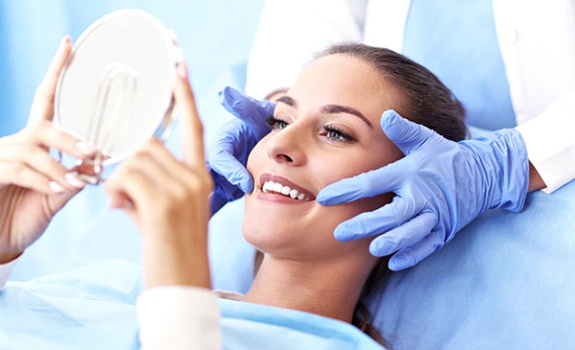
It only takes 2 or 3 visits to get started with Invisalign. Here’s what you can expect:
- We’ll start with a consultation to make sure Invisalign is right for you.
- Then we’ll take X-rays and digital impressions and send them to the Invisalign lab to make your aligner trays.
- Next, you’ll return about 3 weeks to pick up your first set of trays. We’ll review how to wear and maintain them, and you’ll leave wearing your first pair.
- You’ll switch to a new set of aligners about every 2 weeks, and will come back for progress visits every 4 to 8 weeks throughout your treatment.
Who Can Invisalign Help?
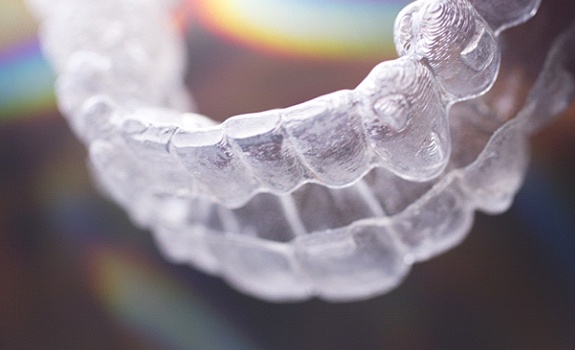
Our goal first and foremost is to make sure you get the best final results. In some cases, that requires traditional braces. In other cases, we can address underbites, overbites, crossbites, gaps, crowding, and more with clear aligners. With this in mind, keep reading to learn how Invisalign can address these common orthodontic issues.
Crowded Teeth

Whether your bottom teeth slightly overlap or you’re dealing with considerable overcrowding, we recommend scheduling a consultation with us so we can determine if you’re a candidate for Invisalign. If you are, then we will create a custom series of clear aligners to gently and gradually guide your teeth into a healthy position.
Gaps Between Teeth
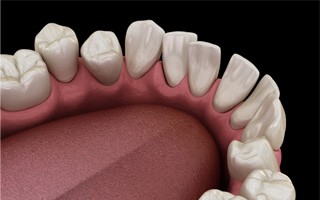
Another common orthodontic issue is spaced-out teeth, which can negatively impact your self-esteem, your oral health, and your bite. The good news is that countless patients have turned to Invisalign for that very reason and achieved beautiful results. Depending on the complexity of your case, you may even see results in a matter of months!
Overbite
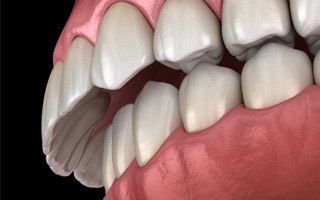
Although you want your upper teeth to protrude beyond your bottom teeth, you don’t want there to be a significant gap. After all, an overbite can result in several complications, including trouble enunciating clearly and chronic jaw pain. Fortunately, rubber bands and other orthodontic accessories can be added to your treatment plan to address this orthodontic problem too.
Underbite
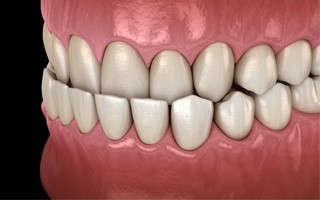
If you have the opposite problem (your lower teeth protrude beyond your upper teeth), then you have an underbite. This bite problem has been linked to everything from TMJ dysfunction to premature wear and tear, so it’s important that you have it corrected. The good news is that Invisalign may be an option if your case isn’t too severe.
Crossbite
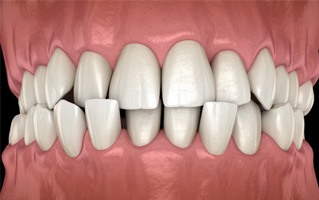
What if some of your lower teeth protrude beyond your upper teeth, and some of your upper teeth protrude beyond your lower teeth? This is a crossbite and, like the others on this list, it can negatively impact the look, health, and function of your smile. The best thing to do is schedule an appointment with us before that happens so we can determine if Invisalign is an option.
Open Bite
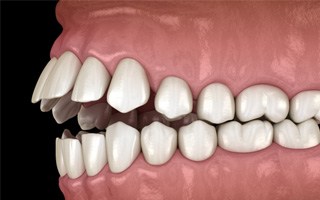
Open bites are often the result of genetics or a childhood habit, like thumb-sucking. Fortunately, it can often be corrected with Invisalign! If you’re a candidate, then we will use the clear aligners (as well as other orthodontic accessories, if needed) to incrementally improve the position of your teeth and your bite.
Invisalign® Teen

Although Invisalign is incredibly popular with adults, we can provide a version of this treatment that is geared more toward teenagers. Invisalign® Teen works similarly to regular Invisalign. With these clear aligners, your son or daughter can enjoy straighter teeth without having to endure “metal mouth” for a year or longer. Instead, they can look back at their high school pictures later on and see only a confident, natural-looking smile! Compared to regular Invisalign, Invisalign Teen has a few small differences that make it more well-suited to straightening younger smiles.
Is My Teen a Good Candidate for Invisalign?

The only way to definitively know whether your teen is eligible for Invisalign is to have them visit an orthodontist. Before that point, though, you should consider a few questions:
- Does your teen have all of their adult teeth? – For some teenagers, the permanent teeth may grow in later than usual, or the “baby” teeth may not have fallen out yet. In cases like these, your teen will most likely need traditional braces rather than Invisalign.
- What orthodontic problems does your teen have? – Invisalign can correct mild to moderate instances of crowding, crookedness, gapped teeth, and bite alignment issues like overbite and underbite. However, if your teen has severe orthodontic problems, such as jaw abnormalities or a major crossbite, then traditional braces may be the only effective treatment.
- How responsible is your teen? – Metal braces stay on the teeth throughout the course of treatment, but Invisalign trays can be removed at any time. If your teen forgets to wear their aligners often enough or doesn’t switch to a new set on time, their treatment may not be as successful.
How Does Invisalign Teen Work?

Once we’ve determined that your teen is a candidate for Invisalign, we’ll take digital scans of their teeth, which are used to create a 100% customized series of clear aligners. Your son or daughter will wear each of these sets of aligners – which adjusts a tiny section of their smile at a time – for about two weeks before moving onto the next one. These aligners should be worn for 22 hours a day – essentially, they should only be removed for eating, drinking, brushing, and flossing.
Invisalign Teen vs. Regular Invisalign

While Invisalign Teen very closely resembles regular Invisalign, two key differences make the former easier and more effective for teenagers:
- More replacement aligners are provided, as teenagers are more likely to lose or damage them in the hustle and bustle of high school life.
- Every aligner has a tiny dot that slowly changes from blue to clear to white as the tray is worn. This not only helps our team know how well your teen is following their treatment guidelines, but it also serves as a reminder for them to switch to the next set of aligners.
Living with Invisalign Aligners

Since Invisalign is one of the most sought-after orthodontic treatments and more than 12 million patients around the world have used clear aligners, there’s a good chance that you already know quite a bit on the topic. But do you know how to meet the wear time daily? Do you know how to clean your trays so they stay clear? Do you know what to do if you accidentally lose one? If not, don’t worry – this next section is dedicated to providing you with the answers.
Wearing Your Trays

Wearing your trays is important because, if you don’t, your teeth won’t track properly. That’s why patients are given the “20-22 hour-a-day” rule. This is exactly what it sounds like: you need to wear your trays for 20-22 hours-a-day, only taking them out to eat, drink anything other than water, and complete your oral hygiene regimen. You might find it helpful to use the stopwatch on your phone until you have a good routine in place too.
Cleaning Your Aligners

You’ll be happy to hear that cleaning your aligners will only take a minute or two. Plus, you only need two things to remove plaque, food particles, saliva, and the like from the surface: clean, cool water and a soft-bristled toothbrush. If you’re wearing your trays for longer than a week at a time, we may also recommend using a clear, mild dishwashing liquid. Of course, you’ll also have the cleaning crystals that came in your Invisalign welcome kit at your disposal.
Eating & Drinking

Since there aren’t any brackets or wires with Invisalign, there aren’t any strict dietary restrictions. In other words, you can enjoy all of your favorite foods throughout your teeth-straightening journey. All you need to do is take your aligners off first so they don’t break, warp, or stain.
Note: You need to remove your trays before drinking anything other than water too, including coffee!
Losing a Tray

Having braces that are clear is a huge perk… until you misplace them. If you find yourself in this situation, then try to retrace your steps, starting from the last place you remember seeing them. There’s a good chance they are in a “random” spot, like between your couch cushions, on the floor by your dining table, or in one of the pockets of the pants you were wearing earlier. If you’ve looked in all of these places but haven’t found them, that’s okay – call us ASAP so we can decide the best way to proceed.
Routine Check-Ins

Every 6-8 weeks, you’ll come into our office so we can determine if your teeth are tracking or not. We’ll do so by taking new scans of your teeth and seeing if they are moving as anticipated. If they aren’t, then we will make some slight adjustments to help you get back on track. If they are, then we will schedule your next appointment and send you on your way with your next batch of aligners.
Benefits of Invisalign

The benefits of Invisalign go beyond just straighter teeth. These clear aligners offer a convenient, comfortable, and stealthy way to transform your smile—all without the “metal mouth.” At Dental Center of Lakewood, we recommend Invisalign to patients who want great results with minimal disruption to their daily lives. From better dental hygiene to boosted confidence, it’s easy to see why Invisalign is a favorite among patients and dentists alike.
Aligners No One Will See

Worried about the look of braces? Invisalign aligners are made from crystal-clear plastic, making them practically invisible when worn. Whether you're chatting with coworkers or taking photos with friends, no one will notice you're in the middle of orthodontic treatment. At our Dallas dental practice, we love giving our patients a way to straighten their teeth without changing their style.
Easy, Breezy Comfort

Traditional braces can poke, rub, and irritate lips and gums. Invisalign trays, on the other hand, are smooth and custom-fit to your teeth. No metal, no wires, just gentle pressure that gradually moves your teeth into place. Our Invisalign-certified dentists, Dr. Spillman and Dr. Green, will make sure your aligners fit just right, so you stay comfortable all day, every day.
Fits Into Your Routine without Stress

One of the biggest benefits of Invisalign is just how easily it fits into any routine. You can remove the trays when eating and brushing, so there are no food restrictions, no special tools, and no major lifestyle changes necessary. Invisalign is focused on making orthodontic care convenient, not adding complexity to your life.
A Cleaner Smile, Every Day

Because Invisalign trays are removable, brushing and flossing are simple. There’s no weaving around brackets or wires, which means you can keep up with your oral hygiene throughout your treatment and reduce your risk of cavities and gum issues. Our Dallas team will help you keep both your aligners and your smile in top shape.
Confidence That Grows with Every Tray

A straighter smile can make a huge difference in how you feel from day to day. With Invisalign, you’ll see progress without drawing attention, and the end result is a smile you’ll love showing off. Our patients often say they feel more confident, even a few months into their treatment, before it’s finished!
Shorter Visits, Less Disruption

Forget the long orthodontist appointments. With Invisalign, check-ins are quick and infrequent, usually only every 6 to 8 weeks. There’s no tightening and no adjustments, just a simple progress check and new trays. We’ll keep your visits efficient, so you can spend more time enjoying life and less time in the dental chair.
Understanding the Cost of Invisalign
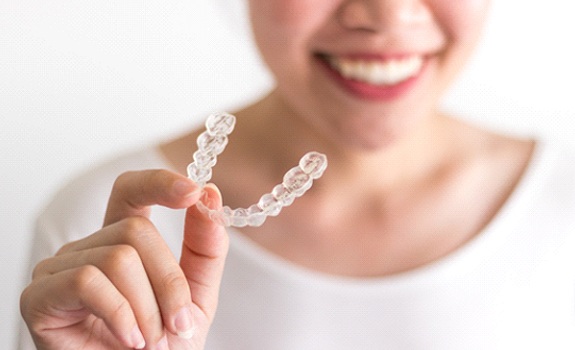
The cost of Invisalign in Lakewood can vary greatly from patient to patient. Since each person’s smile is unique, their Invisalign treatment plan and overall fees will be unique as well. But one thing is certain: Making the decision to invest in your oral health and self-confidence will pay off for life!
And since we want to make having a straight, even smile accessible to as many people as possible, we offer a third-party financing option called CareCredit and are also in-network with Delta Dental Premier. Once you’ve had a consultation, we’ll give you an estimate of your cost and discuss insurance benefits or financing as necessary.
Factors That Affect the Cost of Invisalign
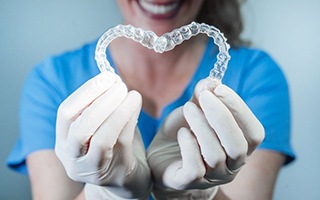
There are three main factors that influence the price of Invisalign:
- Which arch(es) you’re straightening – Most people straighten both their top and bottom teeth, but that’s not always the case.
- Complexity of the required tooth movements – The more your teeth have to shift to achieve a well-aligned smile, the higher your cost of treatment will be.
- Estimated length of treatment – Longer treatment times lead to higher prices because more aligners are required.
At your consultation, your Invisalign dentist in Lakewood will discuss all of these considerations and how they factor into your final treatment price.
Invisalign vs. Smile Direct Club™: A Cost Comparison

Depending on the above factors, Invisalign tends to cost somewhere between $3,000 and $8,000. Smile Direct Club, a mail-order clear aligner kit, rarely exceeds $2,000. So, if you’re looking to quickly and cheaply fix a small number of orthodontic flaws, Smile Direct Club is your best bet.
That said, the cheaper solution is not always better when it comes to dental care. Do-it-yourself clear aligners come with plenty of risks because you receive very little if any supervision from a professional. You may end up shifting your teeth in the wrong way, which would require extensive treatment (and higher dental bills) later on. With the accurate, professionally made Invisalign aligners and the oversight of our dentists, your treatment will be much smoother and more efficient. Invisalign is worth the investment for the peace of mind that this high-quality treatment brings.
Does Dental Insurance Cover Invisalign?

Some dental insurance plans cover a portion of the cost of Invisalign. Others may only cover traditional orthodontics because they view Invisalign as more of a cosmetic treatment. Your level of coverage will depend on the specifics of your plan.
At Dental Center of Lakewood, our insurance expert, Kelli, will be more than happy to look over your insurance policy and help you navigate your benefits. We’re in-network with Delta Dental Premier, but we’ll gladly work with out-of-network plans as well as to help you afford Invisalign in Lakewood.
Options for Making Invisalign Affordable

Even if you don’t have insurance, we can still help you fit the cost of Invisalign into your budget via CareCredit. This financing company offers multiple monthly payment plans to choose from, so you’re sure to find one that works for you. Plus, most of these plans come with very little or even zero interest for qualified patients!
Ultimately, the only way to definitively know how much Invisalign will cost for you is to schedule a consultation with us. Fortunately, we offer a FREE Invisalign consultation to help you find out whether this treatment is right for you!
Invisalign FAQs

Invisalign in Lakewood is a truly unique way to comfortably and conveniently straighten your teeth, so it’s completely natural to have a few questions about it. That’s why we’ve gathered a few of the most common inquiries we get about this revolutionary orthodontic treatment below. If you don’t see the answer you’re looking for, don’t hesitate to call us and we’ll be more than happy to help!
Will Wearing Invisalign Aligners Hurt?
Traditional metal braces are notorious for their sharp wires and brackets that painfully rasp against the soft tissues in your mouth. In comparison, Invisalign aligners are crafted from a single piece of smooth, biocompatible plastic that glides comfortably over your tongue and the inside of your cheeks. When first wearing a new set of aligners, you’ll likely feel some soreness. However, any discomfort should disappear on its own relatively quickly. You can also alleviate your symptoms by taking over-the-counter pain relievers as directed or applying an ice pack. Many patients find it helpful to start a new set of aligners right before bed, which allows them to sleep through any initial discomfort.
Do I Have to Avoid Certain Foods During My Invisalign Treatment?
One of the most popular benefits of Invisalign aligners is their removable nature. This unique feature allows you to continue enjoying all your favorite foods, including items that would damage traditional braces. Simply take out your aligners and store them safely in their case, enjoy your meal, then give your teeth a quick brush before putting them back in! It’s very important that you brush away any lingering particles before you replace your aligners, otherwise they discolor them and increase your risk of cavities. Additionally, it’s not advised to store your aligners in a napkin when you take them out to eat—you could easily throw them away by accident!
Will Invisalign Aligners Change How I Talk?
In the initial stages of your Invisalign treatment, it may sound like you have a slight lisp when you speak. To make certain sounds, your tongue is placed against the back of your teeth. Since these areas are now covered by your aligners, your tongue needs a little bit of time to adapt. Typically, it only takes about a week or so to regain your normal speaking patterns. If you want to speed up the process, try talking aloud and repeating words like “sixty” and “Mississippi.”
Can I Get Invisalign If I’ve Had Metal Braces in the Past?
Many people who had traditional braces in childhood find that their teeth shift out of place years later, especially if they neglect to wear their retainers. Thankfully, Invisalign is an excellent choice for nearly anyone who wants a straighter smile, including those who’ve had traditional braces in the past in most cases. During your Invisalign consultation, your Lakewood dentist will carefully inspect your teeth, jaw, and bite to determine the most effective way to correct your misaligned teeth.
Are you ready to get the smile you’ve always wanted, without the metal braces? Call us to schedule your consultation today and start your journey towards your ideal set of pearly whites!
Can I Drink Coffee with Invisalign?
Yes, you can! In fact, there’s really only one rule when it comes to coffee and Invisalign: you need to take your aligners out before enjoying this caffeinated beverage. If you don’t, then your trays will quickly turn yellow. Plus, there’s the added risk that the aligners will hold the lingering residue against your teeth, increasing your risk of enamel erosion in the process. Simply put, you can continue to drink coffee as long as you take your trays off first.
Note: Since you need to wear your aligners for 20-22 hours a day, consider drinking your coffee alongside your breakfast or lunch since they’ll already be out!
What Should I Do If I Lose an Aligner?
In order to stay on track with your treatment plan, you need to wear your aligners for the vast majority of the day. So, you can see why misplacing an aligner is quite a problem. If this happens to you, then take a few deep breaths and do your best to remember where you last saw them. Then, retrace your steps. If you’ve looked everywhere (including “random” places like the trash can) but can’t find them, call us ASAP.
How Long Does Invisalign Take?
On average, Invisalign takes 12-18 months. Of course, your treatment plan may fall outside of that range; the length of yours depends on factors completely unique to you! A few examples include the complexity of your case, if single-arch treatment is possible, and how many aligners are needed. Don’t worry – we will go over all of these factors and more at your consultation, and we’ll also provide you with a general estimate of your treatment timeline.
How Can I Keep My Invisalign Aligners Clean?
If you’re worried about stubborn stains surfacing, then you’ll be happy to hear that there are several easy ways you can reduce the chances of that happening. First, do not eat or drink anything with your aligners in, including coffee, soda, or wine. Second, rinse your trays thoroughly with clean, cool water each time you take them off. Third, use clean, cool water and a soft-bristled toothbrush to gently remove debris from the surface before you put your aligners back on.
Note: If you notice that your trays are starting to yellow, do not use bleach to clean them. Instead, use the cleaning crystals that came in your welcome kit.
What Happens After My Invisalign Treatment?
Once you’ve completed your time with Invisalign, it will be time to move onto the next phase of your orthodontic treatment: the retention phase. At this time, our focus shifts to preserving the results with a retainer. This is crucial because upwards of 50% of patients experience orthodontic relapse in the years following their orthodontic treatment. In other words, you need to wear your retainer consistently to prevent your teeth from moving out of their straight positions and back into their previously misaligned ones.
I Need a Dental Checkup & Cleaning I Have a Cavity or Broken Tooth I am Missing One or More Teeth I Want to Improve My Smile I am Anxious/Afraid of the Dentist I Want a Straighter Smile I am Worried About Bleeding Gums I am in Pain and Need Help View Our Services
